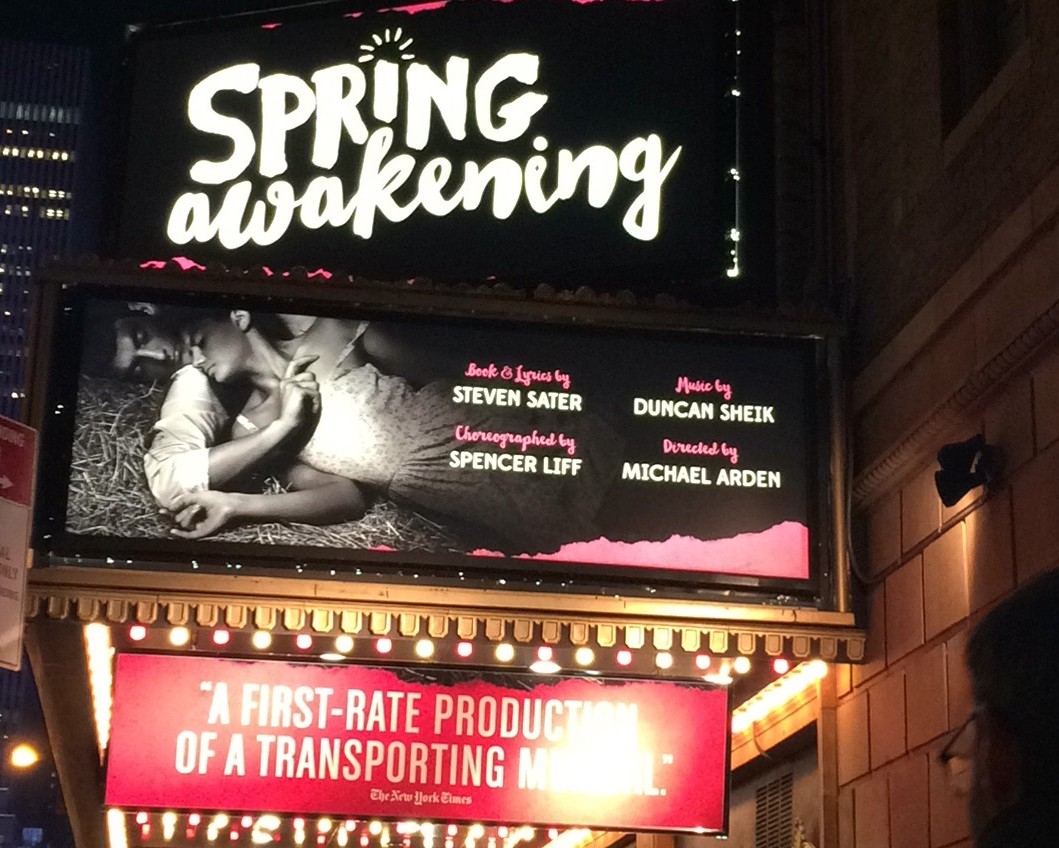You always remember your first time, isn’t that the phrase? I’ll never forget the first time I saw Jonathan Groff and Lea Michele having fake sex at the end of act one of Spring Awakening in January 2007. It was the first Broadway show one of my best friends and I saw together. (Most recently we saw Hamilton at the Public together.) She was a similarly theater-obsessed college freshman who had suggested we get tickets to see this new show that would go on to win the Tony that spring.
Fast forward eight plus years and there’s a revival of Spring Awakening on Broadway for a limited engagement. Clearly I needed to go. And just as clearly I should take my best friend when she comes later this month for five days of theater and hangout time. But said best friend was extremely understanding when I got an email (man, signing up for an email list paid off!) about discounted tickets. We’re still hoping to go when she’s here – because it’s so good, I’d see it again.
If you don’t know the show already, here’s a sound-bite: Set in Germany in 1891, the musical is based on a German play from that year and sets a book with 19th century language against pop-rock music with modern-language lyrics. It’s about teenagers, and sexual repression, and what happens when those teenagers come up against the restrictions placed on them by the adults in their lives. (Short version? Angst. Tragedy. Songs with titles like “Touch Me” and “Totally Fucked”.)
When I first saw the show in 2007, I had mixed feelings. At the end of the first act, my not-quite-nineteen-year-old self was a little overwhelmed. At the end of the second act, my friend and I were in tears. I’ve listened to the music on and off in the years since (more in college than since), enough that I know most of the lyrics well enough to sing along but not so much that I feel an ownership over the show. It’s no Les Mis or Wicked, ingested at formative life moments, but some of the music is still really powerful.
What excited me about this new production was that it’s performed entirely in American Sign Language, right alongside the spoken and sung words. Put on by Deaf West Theatre, a theater company from Los Angeles that focuses on accessible performances, the choreography involves sign language from nearly every character and includes five deaf actors. These deaf actors portray the characters with movement and sign, while their voices are provided by another actor. The voice actors often fade into the background but occasionally interact with the deaf actors in interesting and meaningful ways – almost like conversations one might have with one’s self.
Before I saw the show, I pictured the sign language just as part of the choreography. I didn’t realize how well it would be woven into the plot, adding a whole new layer to the isolation and frustration felt by the teens. The characters played by the deaf actors can be read as deaf themselves for the most part. This means, for instance, that a major character’s difficulties in school stem, in this staging, from the teacher insisting he speak and practice oralism (including techniques like lip reading) instead of signing. I was clued into this aspect of the production right before the show started when I read in the program that eleven years before the original German play premiered back in 1891, the Second International Congress on Education of the Deaf pronounced oralism to be better than sign language. This resulted in sign language being banned in schools across Europe and the US, making this staging historically accurate as well as thoughtfully done. The teenagers all sign to each other, again emphasizing the disconnect between the adults and the teens, between what adults deem acceptable and what teens know to be important.
I’ve always found sign language to be fascinating. I made a friend learn the ABCs with me (from a “Sesame Street” book — she knows who she is) back in elementary school, and when one of my friends started studying ASL in middle school, I had her teach me to sign the Pledge of Allegiance. A few years ago I started watching the ABC Family show “Switched at Birth”, which involves a number of deaf characters, and loved learning about deaf culture through the show. A few of the actors from the show are involved with Spring Awakening, including Academy Award-winning actress Marlee Matlin, also known for playing Joey Lucas on “The West Wing”. I wanted to watch every actor at once, and I was impressed by the clever ways the production ensured that both hearing and deaf audiences could understand the entire show. ASL wasn’t just seamlessly integrated — it enhanced my understanding of character motivations and raised the impact of the entire show.
There’s so much more I could say about this production, but I want to say it to you after you’ve seen it, and it’s only on stage through January 24. Go buy your tickets to this beautiful, sad, complicated, compelling musical, and then after you see it, come talk to me about it, okay?
Photo credit to Kate Phillips, theater buddy extraordinaire.

Leave a Reply